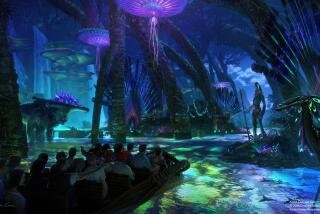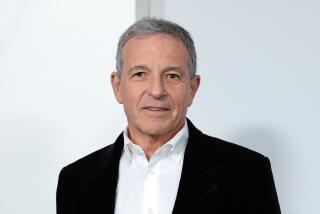Disney’s new theme park in Shanghai may be the capstone to CEO Robert Iger’s career
- Share via
Robert Iger first set foot on the site in China that would become a Walt Disney Co. theme park 17 years ago.
Back then the 963-acre site was mostly agricultural land, but now it has been transformed into Shanghai Disney Resort, a $5.5-billion project that has become an important symbol of Disney’s ambitions in the world’s most populous country.
“It’s kind of hard to believe we’ve been involved so long,” said Iger at the MoffettNathanson Media and Communications Summit in May.
The development, which opens June 16, means a lot to Disney’s chief, who became CEO in 2005 and is expected to depart the company when his contract expires in 2018. And the stakes couldn’t be higher.
Corporate America’s leading CEOs are typically defined by a signature project. Steve Jobs and the iPhone, Lee Iacocca and the Dodge Caravan, Gerald Levin and the Time Warner-AOL merger – the annals of business history are filled with executives who are arguably best known for a signature success or failure.
Several observers said that Iger’s legacy is already secure. He is almost certain to be remembered for how he transformed Disney through the acquisitions of Pixar, Marvel and Lucasfilm, which created a trove of new franchises for the Burbank entertainment giant.
Still, there is little doubt that the opening of the project in Shanghai’s Pudong area represents an important moment for Iger and could provide a capstone to the 65-year-old’s tenure.
“Just what this can give birth to I believe over a long, long period of time, could be very significant for the company,” Iger said at the May event.
At roughly twice the size of Disney’s resort in Anaheim, Shanghai Disney Resort is a behemoth.
The property’s cornerstone Shanghai Disneyland is the third biggest among the company’s dozen theme parks. It includes the largest Enchanted Storybook Castle in the company’s stable, a Tron-themed rollercoaster and Treasure Cove, an area with several “Pirates of the Caribbean” attractions. The resort also includes two hotels, a lake and an entertainment district.
The development represents the biggest partnership between a U.S. entertainment company and a Chinese partner. It is a joint venture with the Shanghai Shendi Group, a state-owned investment entity that holds 57% of the shares. (Disney retains the remainder.)
Shanghai Disney will help promote the company’s brand to a nation of 1.4 billion people who already have access to its merchandise and films. Movies such as “Star Wars: The Force Awakens,” “Iron Man 3” and “Zootopia” have grossed more than $100 million in China in recent years.
“This is a long-term bet on the China market,” said Naveen Sarma, a senior director at Standard & Poor’s who follows Disney.
Shanghai Disney could further boost Disney’s already lucrative parks and resorts business, which has an increased role in the company’s overall success. The parks and resorts division generated $16.2 billion in revenue in 2015, or 31% of overall revenue. That is up from $9 billion in park revenue, or 28% of all company revenue, in 2005.
The Shanghai project broke ground in 2011, with plans to open in 2015. But in 2014, the partners in the development delayed the opening by 18 months and announced plans to spend an additional $800 million on the resort. Disney officials said the extra funding was needed to add new attractions and increase capacity. Now, the project is the most expensive overseas theme park investment made by Disney.
The company already owns a much smaller resort in Hong Kong, but is able to open a park in mainland China in part because of the country’s vast and expanding middle class. An estimated 330 million people live within a three-hour drive or train ride of the Shanghai property.
A recent report by JPMorgan estimated that the resort could contribute about $1 billion in revenue and about $50 million to Disney’s operating profit in fiscal 2017.
“Disney doesn’t have to hit a home run in China,” said Martin Lewison, a theme park expert and business management professor at Farmingdale State College in New York. “If they get a tiny bit of the market, it’s a success.”
But the Shanghai resort is not a slam dunk.
Already, there have been a few issues related to the development, among them the complaints of some pre-opening visitors over the high cost of concessions, which became a talking point on Chinese social media. Also, Chinese conglomerate Dalian Wanda Group has said it will beat back Disney’s China offensive with its own chain of theme parks – even as it has been accused of appropriating Disney intellectual property at one of its amusement parks.
Additionally, Disney has had a mixed record when opening theme parks abroad.
Disney’s resort in Tokyo has largely been a success since it opened in 1983. In 2015, it drew an estimated 16.6 million visitors, the highest attendance of any Disney park outside of the U.S., according to a report from the Themed Entertainment Assn., a nonprofit trade group.
But Disneyland Paris, which launched in 1992, has struggled with low attendance, complaints from employees over the park’s dress code and resistance by French intellectuals, leery of a cultural invasion. Disney has made adjustments to the property over the years, resulting in improvements. Still, in 2014, Disney announced it would spend more than $1 billion on the project, in part to pay down debt.
In Shanghai, Disney has worked hard to get the details just right. Iger has routinely touted the catchphrase “authentically Disney and distinctly Chinese” to explain the company’s effort to marry Chinese culture with Disney’s DNA. The park, for example, includes elements that pay homage to the Chinese zodiac, and forgoes the traditional Main Street entrance found at Disneyland in Anaheim.
Observers expect Disney to deftly walk this tightrope.
“I think there is enough Chinese culture blended in with the Disney culture that it is going to be OK,” said Jim Cora, a former chairman of Disneyland International who left in 2001. “Disney translates in any language.”
While many high-level Disney executives have come and gone during the nearly two decades Shanghai Disney Resort has been under development – among them recently departed Chief Operating Officer Thomas Staggs – Iger has been a constant.
He has delved into issues big and small, visited the property more than 30 times, and seems to be fond of detailing the project’s minutiae. Iger said at the May event that a mountain constructed for one of the Shanghai park’s attractions was built “high enough to be significant,” but not so tall that the Civil Aviation Administration of China “would have forced us to put a red light on the top.”
Although most analysts predict the park will do strong business, any major misstep could stick to Iger, said analyst Alexia Quadrani of JPMorgan.
“To a certain degree it could, no question,” she said. “He is the CEO of the company and this is a major milestone for the company and if it doesn’t go well, it reflects on him.”
Iger wasn’t always going to be at the helm for the park’s opening run.
The executive has twice extended his contract – once in 2011 and again in 2014. That latter deal ensured Iger would be on hand for the first two years of the Shanghai resort’s operation.
When Iger inked the second extension, he told The Times that in addition to being on hand for the relaunch of the “Star Wars” film series, getting the chance to oversee the debut of the Shanghai development was one of the main reasons he decided to stay on board longer.
“That was very, very much on my mind,” he said.
ALSO
Battle for Viacom control flares up; Paramount sale could falter
Disney’s Bob Iger discusses Shanghai resort, ‘Star Wars’ and ESPN at media conference
‘Era of blindly following’ Mickey Mouse is over, says Chinese billionaire battling Disney
More to Read
From the Oscars to the Emmys.
Get the Envelope newsletter for exclusive awards season coverage, behind-the-scenes stories from the Envelope podcast and columnist Glenn Whipp’s must-read analysis.
You may occasionally receive promotional content from the Los Angeles Times.












